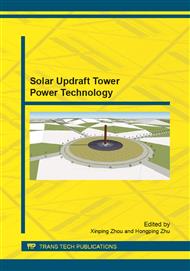p.25
p.35
p.41
p.47
p.57
p.67
p.73
p.87
p.99
Energy from Convective Vortices
Abstract:
An atmospheric vortex engine (AVE) uses an artificially created tornado like vortex to capture the mechanical energy produced during upward heat convection. The vortex is created by admitting warm or humid air tangentially into a circular arena with an open top. The heat source can be solar energy, warm sea water, warm humid air or waste heat. The AVE has the same thermodynamic basis as the solar chimney except that the physical chimney is replaced by centrifugal force in a vortex. The energy is produced in peripheral turbo-generators. The AVE has a large clean and sustainable energy production potential and a small footprint. The paper describes the proposed process and its thermodynamics basis. It then describes progress made to date and current development plans of AVEtec Energy Corporation including economics and plans for commercialization.
Info:
Periodical:
Pages:
73-86
Citation:
Online since:
January 2013
Authors:
Price:
Сopyright:
© 2013 Trans Tech Publications Ltd. All Rights Reserved
Share:
Citation:


